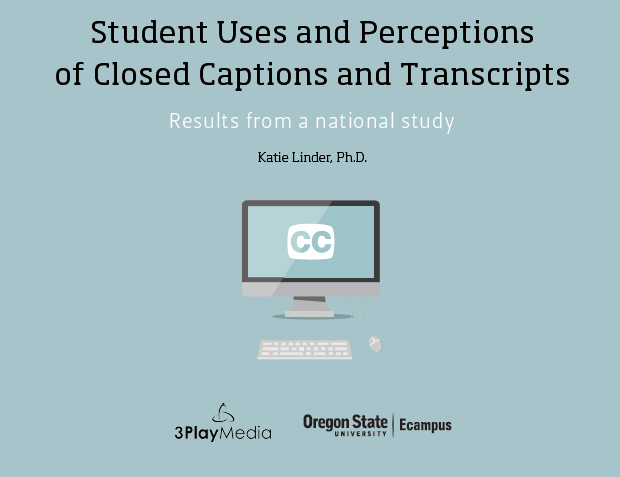This week we are happy to welcome Dr. Katie Linder, Oregon State University Ecampus, as our guest blog post author. Dr. Linder is here to discuss a national research project on student use of closed captions and transcriptions. The important results show that while these resources are not yet widely available, many students, even those who may not need these resources as an accommodation, are able to use transcriptions and captions to increase their success. Thank you Dr. Linder for bringing these important results to our attention!
Enjoy the read,
-Lindsey Downs
Recently, the Oregon State University Ecampus Research Unit completed a national research project in which we surveyed students on their use of closed captions and transcripts to support learning. This study was conducted in collaboration with the closed captioning company 3Play Media. We focused on a broad population of students from 15 colleges and universities who both need these resources for academic accommodation for disability, as well as students who choose to use these resources for access and learning purposes. About 50% of those who responded take most of their courses online.
captioning company 3Play Media. We focused on a broad population of students from 15 colleges and universities who both need these resources for academic accommodation for disability, as well as students who choose to use these resources for access and learning purposes. About 50% of those who responded take most of their courses online.
What We Learned on Student Use of Closed Captions
This data set is one of the first we have that tells us more about how students use closed captions and transcripts in academic environments. Here are some of the things we learned:
- Closed captions are still not being made widely available. When asked in the survey how many videos in their courses had closed captioning or transcripts as an option, only 30% of respondents reported that closed captions were available for “all,” “most,” or “many” videos. Almost an equal number (a combined 26.7%) said that closed captions were available for “just a few” or for “none” of the videos in their courses. Over one quarter of respondents were unsure about the availability of closed captions (27%).
- Transcripts are even less available to students than closed captions. Only 12.2% of students surveyed reported that transcripts were available for “all,” “most,” or “many” videos and 61% said that transcripts were available for “just a few” or for “none” of the videos in their courses. One in five survey respondents were not sure about the availability of transcripts (18.4%).
- When they are made available as resources, students are using closed captions and transcripts to help them learn. When we asked about how students use these tools, their qualitative responses showed that they are using both tools as learning aids. In the case of closed captions, qualitative comments mentioned using them as a learning aid 75% of the time. In the case of transcripts, qualitative comments mentioned using them as a learning aid 85% of the time. More specifically, students use these tools to help with accuracy, comprehension, retention, and engagement.
- Students with and without disabilities are using closed captions and transcripts. When we looked just at the group of students who did not identify as having a hearing impairment or deafness, over 70% of that group were using closed captions at least some of the time. The study clearly shows that closed captions are not just being used by those who need them for disability accommodation purposes.
What Barriers are there for Closed Caption and Transcript Use?
The study also helped us to identify some “hindrances” that students associate with closed captions and transcripts. Here are some of the most common:
- Closed captions are distracting or required too much cognitive load. This was the top hindrance shared in 41% of the qualitative comments on hindrances and students mostly mentioned that their attention strayed to the text rather than the visuals in the video.
- Closed captions include incorrect information. This was the second highest hindrance cited in about 35% of the comments. In particular, survey respondents mentioned things like typos or captions being incorrectly synced with the audio.
- Closed captions block important information. Mentioned in about 32% of the qualitative comments, this hindrance was tied to the design of captions and their placement within the videos.
In the case of transcripts, there was some overlap in the hindrance cited by survey respondents:
- Transcripts are distracting from the video or visual cues or required too much attention or cognitive load. Almost half of survey respondents who offered qualitative comments noted this hindrance.
- Transcripts include incorrect information such as typos, are not well-written, or are not formatted well. About one in five respondents who provided qualitative comments found the lack of accuracy or poor formatting to be a hindrance.
- Transcripts are too long, are too much to read, or require too much time. About 12% of the qualitative comments focused on this hindrance.
- Transcripts are costly and/or inconvenient to print out and carry around. Approximately one in ten students noted this hindrance.
One of the most important things to note is that most of these hindrances are fixable with a strong quality assurance process for the creation of closed captions and transcripts.
Get the Full Report
Interested in learning more about our findings? The full student study report is available for download at 3Play Media’s website. While you’re there, you might also want to check out a second study we completed with 3Play Media on closed captioning implementation at U.S. institutions of higher education.

Dr. Katie Linder
Research Director
Oregon State University E-campus
 captioning company 3Play Media. We focused on a broad population of students from 15 colleges and universities who both need these resources for academic accommodation for disability, as well as students who choose to use these resources for access and learning purposes. About 50% of those who responded take most of their courses online.
captioning company 3Play Media. We focused on a broad population of students from 15 colleges and universities who both need these resources for academic accommodation for disability, as well as students who choose to use these resources for access and learning purposes. About 50% of those who responded take most of their courses online.
5 replies on “Do Closed Captions Help Students Learn?”
Unless I’m mistaken, the report doesn’t actually address the question that is raised in the title of this blog post. That’s very misleading and objectionable (especially since the report itself appears to be carefully titled and well-written to accurately describe the study it describes).
Hi Kevin,
Thanks for your comment. I think you’re right that the report is limited by the students’ self-reports of their learning through closed captions. That’s why the Ecampus Research Unit is also in the process of conducting some experimentally designed studies to measure whether closed caption use impacts short- and long-term retention of information. There are some studies that have already been conducted on this topic, but most are in K-12 populations, or with very specific populations such as college students who are studying foreign languages.
The report just scratches the surface of this topic, but I do think that student self-perceptions of how they believe closed captions are useful as learning tools is a helpful starting point.
Thanks again for your interest in the study!
Best,
Katie
[…] design is good design,” and this is especially true for captioning and usability. In fact, new research out of Oregon State University confirms what smart faculty already know: closed captions and […]
[…] Shorter article from the Dr. Katie Linder, author of the 2016 survey study on caption use. […]
[…] not allowed (or there is too much noise) and ESOL students. In fact, a 2018 study found that over 70% of students without hearing difficulties used captioning at least part of the time when watching course videos. Other benefits […]